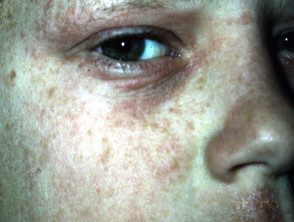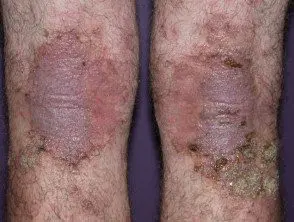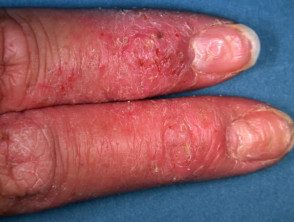What is it atopic dermatitis?
Atopic dermatitis is a chronic, itchy skin that is very common in children but can occur at any age. Also known as eczema and atopic eczema and was formerly known as Besnier prurigo. It is the most common form of dermatitis.
Atopic dermatitis generally occurs in people who have an 'atopic tendency'. This means that they can develop any or all three closely related conditions; atopic dermatitis, asthma and hay fever (allergic rhinitis). Often these conditions occur in families with parents, children, or siblings who are also affected. A family history of asthma, eczema, or hay fever is particularly helpful in diagnosing atopic dermatitis in infants.
Atopic dermatitis arises due to a complex interaction of genetic and environmental factors. These include defects in skin barrier function that make the skin more susceptible to irritation from soap and other contacts. irritants, climate, temperature, and nonspecific triggers: see Causes of atopic dermatitis.
How is atopic dermatitis?
There is great variation in the appearance of atopic dermatitis between individuals. Occasionally, most people have acute flares with inflamed, red, sometimes blistered and watery patches. Between outbreaks, the skin may appear normal or suffer from chronic eczema with dry, thickened and itchy areas.
The presence of infection or an additional skin condition, creams applied, the person's age, ethnicity, and other factors can alter the look and feel of eczema.
However, there are some general patterns about where eczema is in the body based on the age of the affected person.
Childhood atopic dermatitis

Atopic eczema

Atopic eczema

Atopic eczema
Infants
- Babies under one year of age often have widely distributed eczema. The skin is usually dry. scaly and red with little scratch marks made by a sharp baby nail.
- Babies' cheeks are usually the first place affected by eczema.
- The napkin area is frequently saved due to the moisture retention of the diapers. Like other babies, they can develop irritating napkin dermatitis, if wet or dirty diapers are left on for too long.
Atopic dermatitis in preschoolers.

Atopic eczema

Atopic eczema

Atopic eczema
Toddlers and preschoolers
- As children begin to move, eczema becomes more located and thickened Young children scratch vigorously and eczema can look very raw and uncomfortable.
- Eczema in this age group often affects the extensor muscle (external) aspects of the joints, particularly the wrists, elbows, ankles, and knees. It can also affect the genitals.
- As the child grows, the pattern changes frequently to involve flexor surfaces of the same joints (the folds) with less extensor involvement. The affected skin is often lichenized, that is, it dries and thickens from constant scratching and rubbing,
- In some children, the extensor pattern of eczema persists in later childhood.
Atopic dermatitis in school-age children.

Atopic eczema

Atopic eczema

Atopic eczema
School-age children
- Older children tend to have flexural eczema pattern and most often affects the elbow and knee folds. Other susceptible areas include the eyelids, earlobes, neck, and scalp.
- They can develop recurrent sharp itchy blisters on the palms, fingers, and sometimes the feet, known as pompholyx or vesicular hand / foot dermatitis.
- Many children develop a 'nummular' pattern of atopic dermatitis. This refers to small areas of coin-shaped eczema scattered throughout the body. These round patches of eczema are dry, red, and itchy and can be mistaken for ringworm (a fungal infection).
- For the most part, eczema improves during the school years and may disappear entirely in teens, although the skin's barrier function is never completely normal.
Atopic dermatitis in adults.

Atopic eczema

Atopic eczema

Infected dermatitis
Adults
- Adults who have atopic dermatitis can present themselves in different ways.
- They can still have a diffuse eczema pattern but the skin is often drier and lichen than in children.
- Commonly, adults have persistent localized eczema, possibly limited to the hands, eyelids, push-ups, nipples or all of these areas.
- Recurrent staphylococcal infections can be prominent.
- Atopic dermatitis is an important factor contributing to occupational irritant contact dermatitis. This most often affects hands that are frequently exposed to water, detergents, and / or solvents.
- Having atopic dermatitis does not exclude allergic contact dermatitis (confirmed by patch tests) in children and adults)
-
Hand dermatitis in adult atopics tends to be dry and thickened, but can also be blistered.
Persistent atopic dermatitis

Atopic eczema

Atopic eczema

Atopic eczema
See more images of atopic dermatitis and flexural dermatitis.
Does atopic dermatitis persist forever?
Atopic dermatitis affects 15-20% in children, but is much less common in adults. It is impossible to predict whether eczema will improve on its own or not in an individual. Sensitive skin persists throughout life. A meta-analysis that included more than 110,000 subjects found that 20% of children with atopic dermatitis still had persistent disease 8 years later. Fewer than 5% had persistent disease 20 years later. Children who developed AD before age 2 had a much lower risk of persistent disease than those who developed AD later in childhood or during adolescence.
It is unusual for a baby to be affected with atopic dermatitis before four months of age, but may be breastfed. seborrheic dermatitis or other rashes before this. Onset of atopic dermatitis usually occurs before the age of two, although it can manifest itself in older people for the first time.
Atopic dermatitis is often worse between the ages of two and four, but it usually improves after this and may go away entirely in teens.
Certain occupations such as agriculture, hairdressing, house and industrial cleaning, housework, and care expose the skin to various irritants and sometimes Allergens. This aggravates atopic dermatitis. It is wise to keep this in mind when considering career options: It is generally easier to choose a more suitable occupation from the start than to change it later.
What is the treatment for atopic dermatitis?
Treatment of atopic dermatitis may be necessary for many months and possibly years.
It almost always requires:
- Reduction of exposure to triggers (when possible)
- Regular emollients (moisturizers)
- Intermittent current steroids
In some cases, administration may also include one or more of the following:
- Topical calcineurin inhibitors, such as pimecrolimus. cream or tacrolimus ointment
- Chrysabarol ointment
- Antibiotics
- Antihistamines
- Phototherapy
- Oral corticosteroids
Long-standing and severe eczema can be treated with an immunosuppressive agent.
- Methotrexate
- Cyclosporine
- Azathioprine
New biological products are under investigation. The first to be approved for the treatment of atopic dermatitis is:
- Dupilumab
